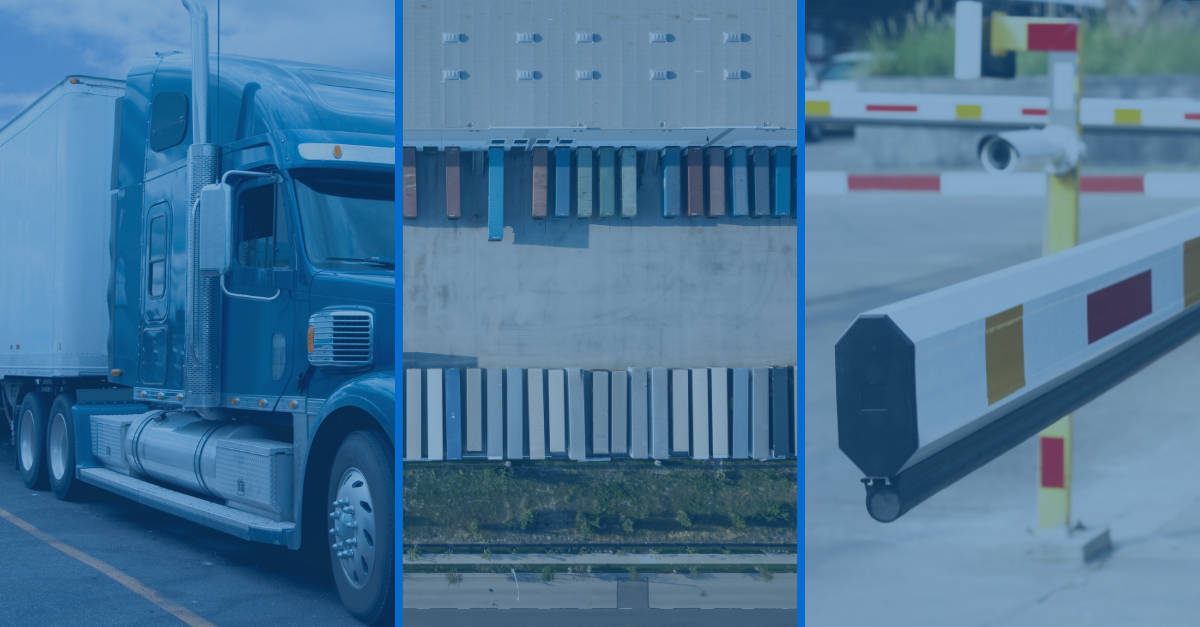Just like last-mile delivery drivers (that is, until a brief pandemic spotlight on “everyday heroes”), yard operations are a largely unsung supply chain player that is vital to businesses and consumers. This makes yard optimization a top priority to ensure operational efficiency.
Yard management, including gate security and vehicle access control, tracking yard assets, and dock scheduling, keeps commerce flowing every day.
The strategic importance of yard management is hard to overstate. When things break down there, it creates a ripple effect of delayed shipments, reduced throughput, costs in labor and equipment utilization, and upset customers.
To prevent this, yard operations managers face a number of challenges. This includes preventing gate logjams, confused dock scheduling, and misplacement of yard assets (trailers, chassis, containers, yard trucks, etc.).
Fortunately, there are strategies that can be applied and technologies leveraged to lessen the impact of these issues on supply chain efficiency.
Leveraging Yard Management Systems (YMS)
The yard management system (YMS) tracks yard assets and inbound/outbound shipments, schedules dock trips, and handles vehicle access control (VAC). Over time, YMS technology has incorporated RFID, GPS, and cloud computing. It monitors vehicle flow, keeps an eye on truck dwell time, and processes arriving and departing vehicles.
The increased yard visibility enabled by a YMS helps reduce bottlenecks and delays. Safety is also improved as yard workers are kept informed of asset locations, helping avoid accidents and injuries. Lastly, customer satisfaction increases when loading/unloading happens in a timely manner, enabling improved order flow.
A YMS can also integrate with a Transportation Management System (TMS), using location data to optimize truck/trailer movements, and coordinate dock scheduling; a Warehouse Management System (WMS) to track arriving inventory; and an Order Management System (OMS) by facilitating cross-docking and prioritizing trailers based on order urgency.
Optimizing Yard Layout and Design
Yard layout has a significant impact on efficiency and safety. Optimizing it reduces truck congestion, enhancing the flow of goods. A poor layout leads to bottlenecks, longer handling times, and safety hazards.
Common Yard Layout Challenges
Yard operations often deal with limited space, irregular traffic patterns, and insufficient signage. These issues can lead to delays and higher costs.
Strategies for Layout Optimization
Strategic placement of docks and storage areas, and maximizing vertical space are two steps toward better design. Proper signage and traffic flow help guide vehicles and workers safely and efficiently. Clearly designated pedestrian areas also help ensure a safer working environment.
Enhancing Scheduling and Dock Management
Proper dock scheduling ensures that trucks arrive and depart on time, improving flow and increasing efficiency.
Impact on Yard Congestion and Delays
Poor scheduling leads to overcrowded yards, causing delays and increasing costs. By managing arrival and departure times efficiently, yard congestion is minimized. Data analytics tools can identify yard traffic patterns and adjust schedules to avoid peak-period congestion.
Role of Dock Management
Efficient dock operations ensure quick turnaround times for loading and unloading, directly impacting supply chain performance. Set specific goals for maximum dock time and regularly review performance data to identify areas for improvement.
Techniques for Better Scheduling
Using an appointment scheduling system, often a YMS feature, helps streamline truck arrivals and departures. Data analytics can predict peak times and allow for adjustments in order to balance traffic flow and prevent congestion.
Best Practices for Dock Management
Prioritizing quick turnaround times is essential. Make sure all docks are properly equipped and maintained to facilitate a smooth workflow. Keeping staff trained on efficient loading and unloading procedures helps reduce delays and increase throughput.
Leveraging AI for Yard Optimization
The rapid growth in artificial intelligence (AI) capabilities has expanded to include solutions designed to optimize yard operations. Augmenting rather than replacing a YMS, they leverage real-time data and analytics to facilitate yard optimization in a number of key ways.
AI for Vehicle Access Control
Advanced AI-powered VAC systems use optical character recognition (OCR) to capture vehicle and driver information for security and verification purposes. They can pull in ID information via real-time data feeds from security cameras. This improves security and speeds up access, reducing idling time and enhancing sustainability efforts.
VAC systems with AI can also be integrated with broader security networks for comprehensive surveillance functions. Enhanced monitoring enables immediate response to security breaches.
AI for Yard Asset Management
AI solutions provide accurate information on vehicle and yard asset movements as they happen, empowering yard managers to anticipate and resolve issues before they escalate.
Real-time asset tracking means yard personnel can quickly and easily locate and access trailers, chassis, and containers, creating better utilization and reducing delays. Also, the inventory count process can be automated, meaning less reliance on personnel.
AI for Dock Scheduling
AI-powered systems drive an overall improvement in “yard vision,” analyzing historical data to predict peak times and optimize scheduling and routing. This reduces yard congestion and helps transportation teams stay on plan.
Enhanced visibility into dock availability, inbound flow, and yard traffic means dock assignments can be updated and revised dynamically based on shipment priorities and other special requirements. This reduces truck dwell time, improves schedule accuracy, and prevents missed cutoffs.
Yard Optimization is Critical to Supply Chain Efficiency
Yard operations are a critical yet often overlooked component of supply chain operations, essential for maintaining the flow of goods. Yard optimization requires leveraging advanced technologies like YMS augmented with AI, optimizing layout and design, and improving scheduling and dock management. Taken together, these tactics can improve efficiency, reduce costs, and enhance safety within yard operations.
EAIGLE is a pioneer in applying AI to yard logistics. Its innovative OCR technology captures data from security cameras to optimize vehicle flow and enhance yard asset management. EAIGLE’s systems for gate management (AVAC™ – Automated Vehicle Access Control) and yard operations (YardSight™) improve operational performance by bringing greater efficiency to both gate access and dock scheduling and queueing. To find out more, request a demo today.


